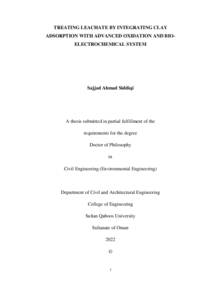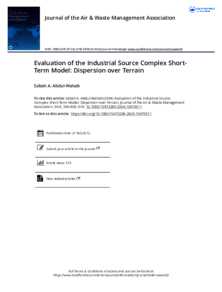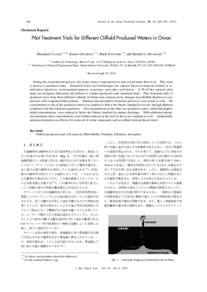Document
Treating leachate by integrating clay adsorption with advanced oxidation and bio-electrochemical system.
Other titles
معالجة الرشح من مكب النفايات بدمج امتصاص الطين مع الأكسدة المتقدمة والنظام الكهروكيميائي الحيوي
Publisher
Sultan Qaboos University.
Gregorian
2022
Language
English
Subject
English abstract
The growing number of municipal solid waste (MSW) landfills could risk leachate
pollution in most countries, especially groundwater resources. Leachate is the highly
contaminated liquid generated from anaerobic reactions and infiltrating rainwater in
MSW landfills. A very high concentration of organic compounds poses a serious
hazard to public health and ecosystems when untreated leachate releases into the
surrounding environment and groundwater. Because of the adverse effects on
ecosystems and the environment, leachate treatment gets a lot of attention. Therefore,
an individual and integrated treatment technique are required to ensure public health
safety and establish a sustainable leachate treatment technology.
The conventional treatment methods are insufficient to fulfill the regulatory discharge
requirements. The fundamental challenges associated with leachate treatment are its
toxic components of humic/fulvic acids, heavy metals, and NH3-N. Most of the recent
leachate treatment technologies have used a series of biological, physical, and
chemical processes. However, none of the current treatment technologies is stand alone. Most integrated technologies are expensive, inefficient, difficult to operate,
unsustainable, and energy-consuming. Therefore, there is an urgent need to develop
new leachate treatment technologies that are eco-friendly, sustainable, easy to operate,
low cost, low energy consuming, less sensitive, and more adaptive to the varying
contaminants. In addition, the newly developed technology should be able to recover
the organics, nitrogen, phosphorous, inorganic-xenobiotics, and energy from leachate.
Hence, the literature survey includes groundwater pollution from open dumping and
non-engineered landfills. Furthermore, it evaluates the strengths and shortcomings of
various leachate treatment technologies currently available. Therefore, this doctoral
dissertation aims to (i) characterize the physical, chemical, and biological properties
of MSW landfill leachate collected from Al-Multaqa (MLL) and Barka landfill (BLL),
Muscat, Sultanate of Oman; and (ii) explore the possibility of applying locally
available Palygorskite clay as an individual adsorbent media to treat the leachate and
determine it kinetics and isotheral behavior; (iii) integrate clay adsorption with
fenton/H2O2 oxidation process to enhance the COD and NH3-N removal; and (iv)
integrate clay adsorption with the bioelectrochemical system (BES) to enhance the
COD and NH3-N removal; (v) evaluate the performance of the individual and
integrated systems (clay-adsorption, fenton/H2O2 oxidation followed by adsorption,
and BES followed by adsorption) to achieve the optimum COD and NH3-N removal.
During leachate characterization, ninety-two (92) leachate parameters were
determined and finally estimated, the leachate pollution index (LPI) to observe the
overall environmental impacts. The study also determined the effect of rainfall on the
leachate pollution parameters and LPI values. The results showed a significantly high
concentration of COD (28000 - 33600 mg/L) and NH3-N (4173 - 4655 mg/L) in the
raw leachate. Rainfall event lowers the concentration of COD (2400-2805 mg/L) and
NH3-N (562-663 mg/L) in the raw leachate up to 83% and 87%. After rainfall, the
normal LPI value 18 - 29% declined to 14 - 28%. The estimated LPI values were higher
than similar studies in the literature. The results were attributed due to unsegregated
MSW dumping into the landfills. Therefore, LPI monitoring is a good indication that
estimates the requirement of leachate treatment.
During individual clay-adsorption treatment, Palygorskite clay was used in four
formats, i.e., raw crushed clay (RCC), 75µ sieved clay (75SC), 75µ sieved calcined
clay (75SCC), and 75µ sieved and washed clay (75SWC). The 75SC showed the
highest removal of COD (43.84%, equivalent to 35.56 mg/g) with the adsorbent dose
of 180 g/L leachate at 9 hours HRT, while the RCC achieved the maximum NH3-N
adsorption (19.39%, equivalent to 1.1 mg/g) at 9-hour HRT. The experimental data fit
the well-known Freundlich isotherm for both the COD and NH3-N removal with R
2 ≈
0.987 and 0.985, respectively. However, the individual clay adsorption did not show
good COD and NH3-N removal performances. Therefore, a Fenton oxidation (FO) was
added as a pretreatment step before clay adsorption to enhance the COD and NH3-N
removal. The results of the integrated system were discussed in the subsequent
paragraphs.
In the oxidation-adsorption integrated treatment, four doses of Fenton reagents, i.e.,
55.6 g, 83.4 g, 166.8 g, 278 g of reagents per Liter leachate (equivalent to 10, 15, 30,
and 50 mM leachates solution), were investigated. Each reagent mixed leachate
solution was kept for five different HRT as 2, 4, 6, 12, and 24 hrs. The results revealed
that the 15 mM reagent dose in the leachate at 6-12 hours HRT produced the best
oxidation performance with COD (35.78%) and NH3-N (35.52%). After the 15 mM
FO, the 180 g 75SWC clay per Litre of leachate was applied as a post-treatment. The
oxidation-adsorption integrated system achieved 59.48% COD and 69.73% NH3-N
removal. The integrated system enhanced the removal efficiencies for COD and NH3-
N compared to the individual clay adsorption. However, the integration of FO did not
significantly improve the COD and NH3-N removal due to utilizing raw leachate
without any dilution. Therefore, an integration of BES as a pretreatment step with clay
adsorption was investigated to observe the removal performances using leachate mixed
wastewater.
In the integrated BES-adsorption study, the BES operated with two different external
resistances (BES operated with 1 Ω was called BES-1, and BES operated with 100 Ω
was called BES-100) utilizing a 1:4 ratio of leachate to wastewater. BES-1 showed
28% COD and 36% NH3-N removal individually, while the BES-100 showed 78.26%
COD and 10% NH3-N removal. Applying 6 g 75SWC adsorption achieved an overall
removal of ~98% COD and ~80% of NH3-N, which demonstrated an efficient
treatment of leachate mixed WW. Such a high removal was achieved due to leachate
dilution and BES addition. Therefore, integration of BES with locally available clay
adsorption for leachate treatment could be considered the best treatment option in
terms of system efficiency and operating cost. Moreover, the application of BES needs
no extra energy and chemicals, which will make the leachate treatment system
sustainable and eco-friendly.
The raw leachate treated by individual clay adsorption showed less COD and NH3-N
removal efficiency. Therefore, it is considered a less suitable leachate treatment
method. However, the method was sustainable due to clay material's low-cost, nonhazardous, and reusable nature. Integrating Fenton-oxidation or BES as a pretreatment
of clay adsorption enhanced the COD and NH3-N removal efficient compared to the
individual clay adsorption. However, the integration of FO was less efficient and
unsustainable due to the requirement of extra oxidizing chemicals. While the
integration of BES was efficient and sustainable due to no need for extra energy and
chemicals. Therefore, the integrated system was recommended to achieve enhanced
leachate treatment in future research.
Member of
Resource URL
Arabic abstract
يمكن أن يؤدي العدد المتزايد من مدافن النفايات الصلبة البلدية )MSW )إلى خطر تلوث العصارة في معظم البلدان ، وخاصة موارد المياه الجوفية. الراشح هو السائل شديد التلوث الناتج عن التفاعالت الالهوائية وتس ّرب مياه الامطار في مدافن النفايات الصلبة المحلية. يشكل التركيز العالي جدًا للمركبات العضوية غير التقليدية خط ًرا خطي ًرا على الصحة العامة والنظم البيئية عند إطالق العصارة غير المعالجة في البيئة المحيطة والمياه الجوفية. نظ ًرا للتأثيرات الضارة على النظم البيئية والبيئة ، تحظى معالجة العصارة باهتمام كبير. لذلك ، هناك حاجة إلى تقنية معالجة فردية ومتكاملة لضمان سالمة الصحة العامة وإنشاء تقنية معالجة العصارة المستدامة. طرق العالج التقليدية غير كافية للوفاء بمتطلبات التفريغ التنظيمية. تتمثل التحديات الاساسية المرتبطة بمعالجة العصارة في مكوناتها السامة من الاحماض الدبالية / الفولفيك ، والمعادن الثقيلة ، و N3-NH. استخدمت معظم تقنيات معالجة العصارة الحديثة سلسلة من العمليات البيولوجية والفيزيائية والكيميائية. ومع ذلك ، ال توجد أي من تقنيات العالج الحالية قائمة بذاتها. معظم التقنيات المتكاملة باهظة الثمن وغير فعالة وصعبة التشغيل وغير مستدامة ومستهلكة للطاقة. لذلك ، هناك حاجة ملحة لتطوير تقنيات جديدة لمعالجة العصارة تكون صديقة للبيئة ومستدامة وسهلة التشغيل ومنخفضة التكلفة ومنخفضة استهالك الطاقة وأقل حساسية وأكثر تكيفًا مع الملوثات المختلفة. ا قادرة على استعادة المواد العضوية والنيتروجين بالاضافة إلى ذلك ، يجب أن تكون التكنولوجيا المطورة حديثً والفوسفور والمواد الغريبة الحيوية غير العضوية والطاقة من العصارة. ومن ثم ، فإن المسح الادبي يشمل تلوث المياه الجوفية من مكبات النفايات المكشوفة والمدافن غير المهندسة. عالوة على ذلك ، فإنه يقيم نقاط القوة والقصور في مختلف تقنيات معالجة العصارة المتاحة حاليا. لذلك ، تهدف أطروحة الدكتوراه هذه إلى )1( توصيف الخصائص الفيزيائية والكيميائية والبيولوجية لعصير مكب النفايات الصلبة الذي تم جمعه من الملتقى )MLL ) ومكب بركاء )BLL )، مسقط ، سلطنة عمان ؛ و )2( استكشاف إمكانية تطبيق طين Palygorskite المتاح محليًا كوسائط ماصة فردية لمعالجة المادة المرتشحة وتحديد حركتها وسلوكها المتساوي الحرارة ؛ )3( دمج امتصاص الطين مع عملية أكسدة 2O2H / fenton لتعزيز إزالة COD و N3-NH ؛ و )4( دمج امتصاص الصلصال مع النظام الكهروكيميائي الحيوي )BES )لتعزيز إزالة COD و N3-NH ؛ )5( تقييم أداء الانظمة الفردية والمتكاملة )امتصاص الطين ، وأكسدة 2O2H / fenton متبو ًعا بالامتصاص ، و BES متبو ًعا بالامتصاص( لتحقيق إزالة COD و N3-NH المثلى. ( عامًال أثناء توصيف المادة المرتشحة ، تم تحديد اثنين وتسعين )92 للمادة المرتشحة وتقديرها أخي ًرا ، مؤشر تلوث المادة المرتشحة )LPI )لمالحظة التأثيرات البيئية الكلية. كما حددت الدراسة تأثير هطول الامطار على معامالت تلوث المادة المرتشحة وقيم مؤشر الاداء الفعلي. أظهرت النتائج وجود تركيز عالي معنوي من COD )28000 - 33600 مجم / لتر( و N3-NH( 4173 - 4655 مجم / لتر( في العصارة الخام. يقلل هطول الامطار من تركيز COD( 2805-2400 مجم / لتر( و N3-NH( 663-562 مجم / لتر( في العصارة الخام بنسبة تصل إلى ٪83 و .٪87 بعد هطول الامطار ، انخفضت قيمة LPI الطبيعية من 18 إلى ٪29 إلى .٪28-14 كانت قيم LPI المقدرة أعلى من الدراسات المماثلة في الادبيات. تُعزى النتائج إلى إلقاء النفايات الصلبة البلدية غير المنفصل في مكبات النفايات. لذلك ، يعد رصد LPI مؤش ًرا جيدًا لتقدير متطلبات معالجة المادة المرتشحة. أثناء المعالجة الفردية المتصاص الطين ، تم استخدام طين Palygorskite بأربعة أشكال ، أي الطين المسحوق الخام )RCC )، والطين المنخل 75 درجة )75SC )، والطين المكلس 75 درجة )75SCC )، والطين المنخل والمغسول 75 درجة مئوية )75 درجة مئوية(. أظهر 75SC أعلى إزالة لـ COD( ٪43.84 ، ما يعادل 35.56 مجم / جم( بجرعة ممتصة من 180 جم / لتر من العصارة عند 9 ساعات HRT ، بينما حقق RCC أقصى امتصاص N3-NH( ٪19.39 ، ما يعادل 1.1 مجم / جم( عند العالج التعويضي بالهرمونات لمدة 9 ساعات. تتالءم البيانات التجريبية مع متساوي الحرارة Freundlich المعروف إلزالة COD و N3-NH مع 0.987 R ًء جيدًا إلزالة COD و N3-NH. لذلك ، و 0.985 ، على التوالي. ومع ذلك ، لم يُظهر امتزاز الطين الفردي أدا X تمت إضافة أكسدة (FO (Fenton كخطوة معالجة مسبقة قبل امتزاز الطين لتعزيز إزالة COD و N3-NH. نوقشت نتائج النظام المتكامل في الفقرات الالحقة. في المعالجة المتكاملة لألكسدة والامتصاص ، تم فحص أربع جرعات من كواشف فنتون ، أي 55.6 جم ، 83.4 جم ، 166.8 جم ، 278 جم من الكواشف لكل لتر من العصارة )ما يعادل 10 ، 15 ، 30 ، و 50 ملي موالر من محلول الراشح(. . تم الاحتفاظ بكل محلول راشح مختلط من الكاشف لمدة خمس ساعات مختلفة HRT في 2 و 4 و 6 و 12 و 24 ساعة. أوضحت النتائج أن جرعة الكاشف 15 ملي موالر في العصارة عند 12-6 ساعة أعطت أفضل أداء أكسدة مع COD( ٪35.78 )و N3-NH( ٪35.52). بعد 15 ملي موالر من الطين ، 180 جم 75 مياه كربون طين لكل لتر من المادة المرتشحة كعالج الحق. حقق النظام المتكامل لألكسدة والامتصاص ٪59.48 COD و ٪69.73 N3-NH. عزز النظام المتكامل كفاءات الازالة لـ COD و N3-NH مقارنة بامتصاص الطين الفردي. ومع ذلك ، فإن تكامل FO لم يحسن بشكل كبير إزالة COD و N3-NH بسبب استخدام العصارة الخام دون أي تخفيف. لذلك ، تم التحقيق في تكامل BES كخطوة معالجة مسبقة مع امتصاص الطين لمراقبة أداء الازالة باستخدام مياه الصرف الصحي المختلطة بالمادة المرتشحة. في دراسة امتزاز BES المتكاملة ، عملت BES بمقاومتين خارجيتين مختلفتين )BES التي تعمل بـ 1 كانت تسمى -1BES ، وتم تشغيل BES بـ 100 كان يسمى -100BES )باستخدام نسبة :1 4 من العصارة إلى مياه الصرف الصحي . أظهر -1BES إزالة ٪28 COD و ٪36 N3-NH بشكل فردي ، بينما أظهر -100BES إزالة ٪78.26 COD و ٪10 N3-NH. أدى تطبيق 6 جم من امتصاص 75SWC إلى إزالة شاملة لما يقرب من 98 ٪ من COD و 80 ٪ من N3-NH ، مما أظهر معالجة فعالة للعصارة المختلطة WW. تم تحقيق هذا الازالة العالية بسبب تخفيف المادة المرتشحة وإضافة BES. لذلك ، يمكن اعتبار تكامل BES مع امتزاز الطين المتاح محليًا لمعالجة المادة المرتشحة أفضل خيار معالجة من حيث كفاءة النظام وتكلفة التشغيل. عالوة على ذلك ا ، ال يحتاج تطبيق BES إلى طاقة ومواد كيميائية إضافية ، مما يجعل نظام معالجة العصارة مستدا ًما وصديقً للبيئة. أظهرت العصارة الخام التي عولجت بامتصاص طيني فردي أقل كفاءة إزالة COD و N3-NH. لذلك ، تعتبر طريقة معالجة المادة المرتشحة أقل مالءمة. ومع ذلك ، كانت الطريقة مستدامة بسبب طبيعة مادة الطين منخفضة التكلفة وغير الخطرة والقابلة إلعادة الاستخدام. أدى دمج أكسدة Fenton أو BES كمعالجة مسبقة المتصاص الطين إلى تعزيز إزالة COD و N3-NH بكفاءة مقارنة بامتصاص الطين الفردي. ومع ذلك ، فإن تكامل FO كان أقل كفاءة وغير مستدام بسبب الحاجة إلى مواد كيميائية مؤكسدة إضافية. في حين أن تكامل BES كان فعالا ومستدا ًما بسبب عدم الحاجة إلى المزيد من الطاقة والمواد الكيميائية. لذلك ، تمت التوصية بالنظام المتكامل لتحقيق معالجة محسنة للمادة المرتشحة في البحوث المستقبلية.
Category
Theses and Dissertations



